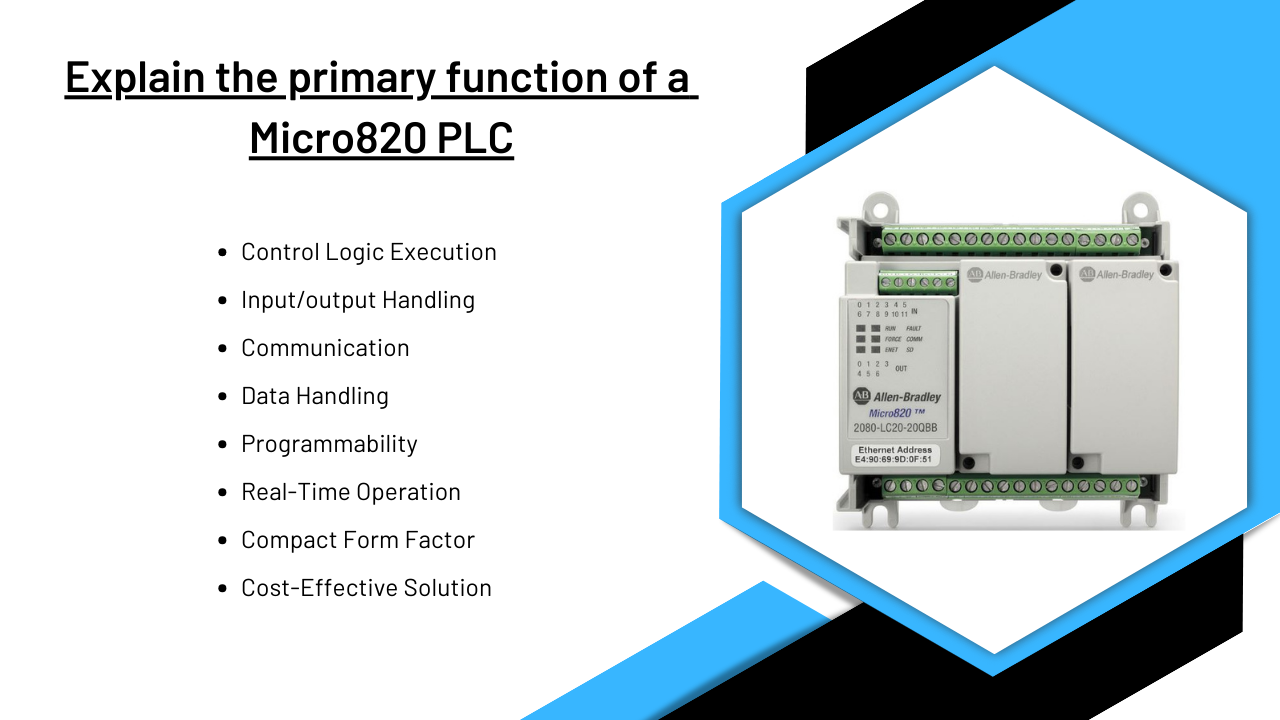
The Micro820 Programmable Logic Controller (PLC) is a compact and cost-effective industrial automation device manufactured by Rockwell Automation. The primary function of the Micro820 PLC is to control and automate various processes in industrial settings. Here are some key aspects of its primary functions:
1. Control Logic Execution:
- The Rockwell Automation Micro820 PLC Systems is designed to execute control logic, which is a set of programmed instructions that define the behavior of a system or a machine.
- It uses a programming language, typically ladder logic or function block diagrams, to create sequences of operations that control the connected machinery and processes.
- The PLC operates in a continuous loop known as a “scan cycle.” During each scan cycle, the PLC reads inputs, executes the programmed logic, and updates outputs.
- The Micro820 PLC continuously monitors the state of input devices connected to its input terminals. These devices can include sensors, switches, and other field devices.
2. Input/output Handling:
- The Micro820 PLC interfaces with various sensors, switches, and other input devices to monitor the status of the controlled system.
- It also communicates with output devices such as motors, valves, and other actuators to execute commands based on the programmed logic.
- The Micro820 PLC supports both digital and analog inputs. Digital inputs typically represent binary states (on/off), while analog inputs can provide a range of values, allowing for more precise control
3. Communication:
- The Micro820 PLC supports communication with other devices, allowing it to integrate into larger automation systems. This can include communication with Human Machine Interface (HMI) devices, other PLCs, or supervisory control systems.
- The PLC can communicate with Human Machine Interface (HMI) devices, allowing operators and engineers to monitor the system status, make adjustments, and receive feedback from the PLC.
4. Data Handling:
- The PLC can handle data, both in terms of input data from the field devices and internal data used for calculations and decision-making.
- It may include features for data storage, retrieval, and manipulation to support the control logic.
- Control logic within the PLC can retrieve data from input devices, sensors, or other sources. This data is then used in decision-making processes or for further calculations.
- The Micro820 PLC provides instructions and functions for manipulating data. This includes arithmetic operations, comparisons, bitwise operations, and other operations necessary for processing and transforming data according to the control requirements.
5. Programmability:
- Users can program the Micro820 PLC using specialized software, such as Rockwell Automation’s Connected Components Workbench (CCW).
- The programming environment provides tools to create, edit, and troubleshoot the control logic, making it flexible for a wide range of applications.
- Rockwell Automation provides a dedicated software tool, often referred to as an Integrated Development Environment (IDE), for programming the Micro820 PLC. For example, the Connected Components Workbench (CCW) is commonly used for Micro800 series PLCs.
6. Real-Time Operation:
- The Micro820 PLC operates in real-time, meaning it responds to input signals and executes control logic with minimal delay. This is crucial for ensuring the timely and accurate control of industrial processes.
- The PLC operates on a continuous loop known as a scan cycle. During each scan cycle, the PLC reads inputs, executes control logic, and updates outputs. The duration of the scan cycle is typically constant and is a key factor in achieving real-time performance.
7. Compact Form Factor:
- As the name suggests, the Micro820 PLC is designed to be compact, making it suitable for applications with limited space.
- Many compact PLCs, including the Micro820, are designed for DIN rail mounting. DIN rail mounting is a standardized method that allows for easy and secure installation of control components within industrial environments.
- The compact size facilitates the creation of modular systems, allowing users to build and expand their control infrastructure in a scalable manner. This is particularly beneficial in applications where space considerations are a primary concern.
- Compact PLCs are often designed with ruggedness in mind, suitable for deployment in harsh industrial environments. The Micro820, while compact, is engineered to withstand challenging conditions commonly encountered in manufacturing and automation settings.
8. Cost-Effective Solution:
- The Micro820 PLC is positioned as a cost-effective solution for small to medium-sized automation projects, providing essential control capabilities without the complexity and cost associated with larger PLCs.
- The Micro820 PLC is designed for ease of integration into control systems. This can result in cost savings related to installation and commissioning, as well as reduced downtime during system upgrades or expansions.
- Compact PLCs like the Micro820 often have lower power consumption compared to larger counterparts. This not only reduces operational costs but also may result in cost savings in terms of power infrastructure requirements.
In summary, the Micro820 PLC is a versatile industrial automation device that performs control, monitoring, and automation tasks in a compact and cost-effective manner, making it suitable for various applications in industrial settings.

Tech Hub Digital, a one-stop destination for complete technology-related information.

